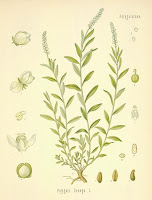 |
| Found via Google Books, aka "the researcher's friend" |
The plant (general species, Senega - sometimes spelled Seneca) was originally identified into modern medicine, in the 18th century by a Scottish physican, whose attention was brought to it by the Seneca tribe in Pennsylvania. The plant had (and continues to have) important properties used in medical products to this day. It is also important in alternative medicine, as demonstrated at this Manitoba website showcasing local herbal remedies - all available to me in my backyard.
Trivia: Metis (introduced to it by the Ojibwa) have long used Senega/Senega, aka Snakeroot, for it's medicinal properties.
I found it fascinating to run across this medical journal report of the find from 1892 (especially since the natives in our area are mentioned as using it mainly for subsistence purposes, not medicinal as tribes in other areas of the country had...)
THE AMERICAN
JOURNAL OF PHARMACY.
MARCH, 1892.
NORTHERN SENEGA.
By L. E. Sayre, University of Kansas.
The geographical distribution of senega has been a subject of a good deal of interest to the members of the pharmaceutical profession and the drug trade for a number of years. Chief among the contributors to our present knowledge of the drug in this particular have been Prof. J. M. Maisch and Prof. J. U. Lloyd, as will be seen by glancing over the back numbers of the American Journal of Pharmacy, the Proceedings of the American Pharmaceutical Association, and other pharmaceutical publications.
Reference has been made to senega growing in Wisconsin and Minnesota, but there has not been very definite information given, I believe, as to its collection or the exact district of country from which it is collected in these States. "Northern Senega" has been a current term meaning a variety of senega having certain physical characteristics very unlike the original Polygala Senega. Prof. Lloyd (Proc. Amer. Pharm. Asso., 1881), describing this variety1 — which he says is derived from the Northwest from the States of Wisconsin and Minnesota—says it is very large and fleshy, sometimes white, again rather dark brown, the knotty crown measuring often from two to three inches in diameter, even of the dried plant. The root just below the knotty head is (when dry) from the size of the little finger to that of the thumb of a man ; six to ten inches in length and generally destitute of keel; not so contorted and branched as the " Southern " senega.
 |
| Northern Seneca Root harvested in Manitoba |
The root referred to is undoubtedly a good sample of senega. In length it varies from 4 to 8 inches; in diameter from 1/16 to 1/2 inch. Surrounding the root is a dark scar-covered head. This head in the case of younger roots is covered with immature pinkish leaf-covered stems. The characteristic keel of Southern senega is rarely present and the contour of the root is much less contorted. The color ranges from the light yellow of young roots to the dark brown of the older ones.
Near the head, prominent annulations are present. These continue with enlarging intervals of space for some distance down the root. Lengthwise the whole root is deeply wrinkled, while frequent warty enlargements occur. The branches are not numerous. In considerable quantities, the odor of gaultheria is quite prominent, as it is also in a cold aqueous infusion. The taste is very acrid.
Under the microscope the wood is found to be cylindrical, and the ingrowth of the inner bark on one side which produces the keel of the Southern variety is not apparent in a majority of cases. The wood is whitish, ligneous and occupies about y of the diameter of the root.
A sample of the drug was handed to Mr. McClung, one of the senior students, for the estimation of the polygalic acid. He used Quevenne's process, and obtained of the pure acid 35 per cent. Methyl salicylate was abundant, as shown by the ferric chloride test.
It would seem from the above that this specimen handed to me by Prof. Dyche represented a good sample of senega; its quality, equal to the average root of the market.
I have planted some of the roots, which seem to be full of vigor, and hope to be able at some future time to classify the plant.
1 — Northern senega, collected in the northwest United States, is considerably larger than the usual variety (western senega), and darker in colour; it is less contorted and shows the keel less distinctly, but it has a very acrid taste, and is undoubtedly a good senega. It is said to be derived from Poly gala Senega, var. latifolia.
2 - Jadis (named for Mr. Jadis, Kittson County Auditor) eventually was renamed Roseau - Kittson county included the western portion of what is now Roseau County until 1894 - From Kittson County History.

No comments:
Post a Comment